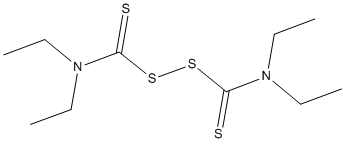All AbMole products are for research use only, cannot be used for human consumption.

Disulfiram (Tetraethylthiuram disulfide) is a specific inhibitor of aldehyde-dehydrogenase (ALDH1). Disulfiram is used in the study of chronic alcoholism, with acute sensitivity to alcohol, and is a potent copper ion-carrier that can be used in cuproptosis studies. Disulfiram inhibits gasdermin D (GSDMD) pore formation in liposomes and inflammasome-mediated pyroptosis and IL-1β secretion in human and mouse cells. Disulfiram + Cu2+ increases intracellular ROS levels triggering apoptosis of ovarian cancer stem cells.

Biomed Pharmacother. 2024 Jun 21.
The combination therapy using tyrosine kinase receptors inhibitors and repurposed drugs to target patient-derived glioblastoma stem cells
Disulfiram purchased from AbMole

JACC-BASIC TRANSL SC. 2023 May 31.
PCSK9 Promotes Hypoxia-Induced Endothelial Cell Pyroptosis by Regulating Smac Mitochondrion-Cytoplasm Translocation in Critical Limb Ischemia
Disulfiram purchased from AbMole

Patent. CN114686433A 2022 Jul 01.
Patent. CN114686433A
Disulfiram purchased from AbMole
| Molecular Weight | 296.54 |
| Formula | C10H20N2S4 |
| CAS Number | 97-77-8 |
| Form | Solid |
| Solubility (25°C) | DMSO 60 mg/mL |
| Storage |
Powder -20°C 3 years ; 4°C 2 years In solvent -80°C 6 months ; -20°C 1 month |
[3] Chen Lu, et al. Disulfiram: a novel repurposed drug for cancer therapy
| Related Pyroptosis Products |
|---|
| INF 195
INF 195 is an NLRP3 inhibitor. |
| Azalamellarin N
Azalamellarin N is an inhibitor of pyroptosis and has different inhibitory effects on different pyroptosis inducers. Azalamellarin N inhibits pyroptosis by targeting molecules that act upstream of NLRP3 inflammasome activation, rather than directly targeting components of the NLRP3 inflammasome. |
| Sodium metatungstate
Sodium metatungstate (Sodium polyoxotungstate) is a potent ecto-nucleoside triphosphate diphosphohydrolase (ENTPDase) inhibitor, with Ki values of 2.58 μM, 3.26 μM, and 28.8 μM for NTPDase 1 (CD39), NTPDase 3 and NTPDase 2 respectively. |
| LDC7559
LDC7559 is a gasdermin D (GSDMD) inhibitor via blocking neutrophil extracellular trap (NET) in the late stages . |
| CY-09
CY-09 is a selective direct inhibitor of NLRP3 with anti-inflammatory and antidepressant activity, which inhibits inflammatory cytokine production and TRPA1 activation by inhibiting the activation of the NLRP3 inflammatory vesicle, thereby decreasing the intracellular Ca2+ level and reducing the pro-inflammatory polarization of macrophages, alleviating pain and injury in animals. In addition, CY-09 can inhibit pyroptosis. |
All AbMole products are for research use only, cannot be used for human consumption or veterinary use. We do not provide products or services to individuals. Please comply with the intended use and do not use AbMole products for any other purpose.


Products are for research use only. Not for human use. We do not sell to patients.
© Copyright 2010-2024 AbMole BioScience. All Rights Reserved.
